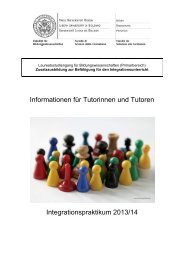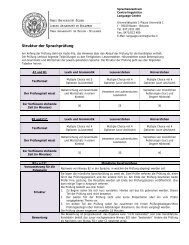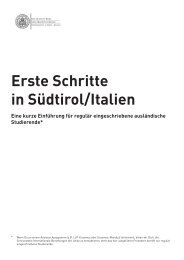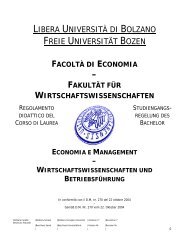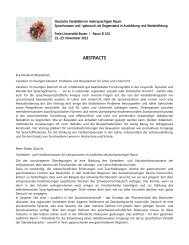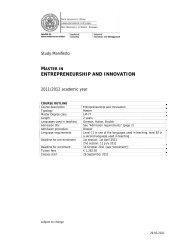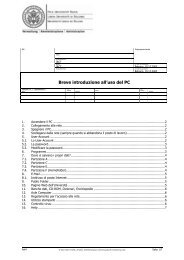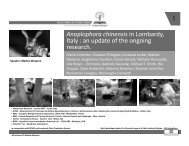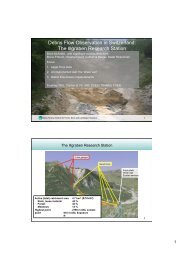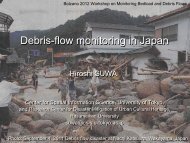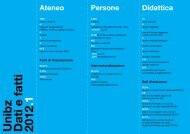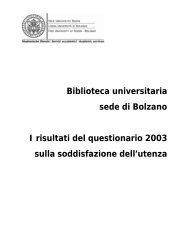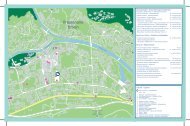You also want an ePaper? Increase the reach of your titles
YUMPU automatically turns print PDFs into web optimized ePapers that Google loves.
28<br />
zione grafica semplice e riproducibile,<br />
riescono a esporre i loro contenuti in<br />
maniera più incisiva e rapida <strong>di</strong> quanto<br />
potrebbe fare la scrittura. Tuttavia,<br />
poiché a <strong>di</strong>fferenza delle più note forme<br />
pittografiche, le immagini sono ambivalenti,<br />
in qualunque ambito emergono<br />
anche dei limiti al loro impiego, pur<br />
restando una valida opzione per ridurre<br />
la testualizzazione.<br />
languages on the spot:<br />
Visual communication in a<br />
multi-lingual space<br />
In a Europe without borders,<br />
language barriers are the only visible<br />
<strong>di</strong>vi<strong>di</strong>ng lines between regions. Signs,<br />
inscriptions, publicity and wall<br />
painting are all part of the visual<br />
communication that shapes public<br />
space and its perception with their<br />
messages. It is also suitable as a reliable<br />
in<strong>di</strong>cator for the current social situation<br />
of a place. Precisely in multi-lingual<br />
regions it functions as a mirror image<br />
for the status of multilingualism. It is<br />
not irrelevant then which language is<br />
‘superior’ and whether <strong>di</strong>alects appear<br />
in the standard language. The visibility<br />
of one language compared to another<br />
*<br />
Un gruppo <strong>di</strong> lavoro inter<strong>di</strong>sciplinare della <strong>Libera</strong> <strong>Università</strong><br />
<strong>di</strong> <strong>Bolzano</strong> (Dal Negro, Lensink, Upmeier, Volonté) sta<br />
esplorando le modalità <strong>di</strong> funzionamento della comunicazione<br />
visiva nelle aree multilingui. Mettendo insieme competenze<br />
nei settori della linguistica, della sociologia e del design, ha<br />
origine un’analisi comparativa <strong>di</strong> regioni plurilingui in Europa,<br />
sull’ esempio del traffico <strong>di</strong> autobus a lunga percorrenza e<br />
delle sue stazioni in alcune città selezionate. Da questo stu<strong>di</strong>o<br />
ci atten<strong>di</strong>amo una maggiore comprensione dei problemi ricorrenti,<br />
nonché esempi <strong>di</strong> soluzioni impreve<strong>di</strong>bili nella comunicazione<br />
visiva multilingue. L’obiettivo è quello <strong>di</strong> giungere a<br />
un catalogo <strong>di</strong> criteri generalizzabili, impiegabili nell’ ambito<br />
del plurilinguismo.<br />
can also be measured by the number<br />
of messages that appear only in one<br />
language or the other. The use of<br />
language can also vary accor<strong>di</strong>ng to<br />
the sender. Institutional messages often<br />
observe the specified multilingualism.<br />
On the other hand, for the sake of<br />
simplicity, private or business messages<br />
often use only one language, namely<br />
that which the user knows or in<br />
which he expects to be understood.<br />
In ad<strong>di</strong>tion to this pictures can be<br />
used. An elementary function of visual<br />
communication is to create a reciprocal<br />
meaning using pictures and language.<br />
While language demands previous<br />
knowledge, pictures do not, at least<br />
initially, need any translation. The use<br />
of pictures therefore could be helpful<br />
for communication that does not need<br />
language. But are the precon<strong>di</strong>tions<br />
<strong>di</strong>fferent for understan<strong>di</strong>ng in a<br />
multilingual space? If, for example in<br />
South Tyrol, the the two main linguistic<br />
groups though living in one place are<br />
segregated from each other culturally<br />
mainly by single language families,<br />
separate school systems and me<strong>di</strong>a, this<br />
will also influence the meanings that<br />
emerge from pictures.<br />
“Visual communication” as a<br />
<strong>di</strong>scipline in training designers includes<br />
all me<strong>di</strong>a with which signification<br />
and consequently communication<br />
can be obtained. It does not comprise<br />
primarily the use of pictures. In fact,<br />
written language was, and continues<br />
to be, the most important me<strong>di</strong>um of<br />
information. Typography, with its 500<br />
year-old tra<strong>di</strong>tion, plays an important<br />
role here for structuring texts. The<br />
choice of typeface, its style (normal,<br />
italic, bold), and its size are a fine but<br />
coherent means of <strong>di</strong>fferentiation. A<br />
typographical hierarchy, and the visual<br />
<strong>di</strong>fferences that result from it, can<br />
enhance the readability of messages.<br />
This is all the more essential if the<br />
messages are written in two languages.<br />
Often these come close to the limits of<br />
the format and the size of its support.<br />
Multilingual visual communication<br />
does require more space. In this<br />
case pictures could partly replace<br />
the doubled information in the text,<br />
through pictograms for example. These<br />
were used initially for wayfin<strong>di</strong>ng<br />
systems at airports and have now been<br />
used in public spaces systematically for<br />
50 years. Their graphically simple and<br />
An inter<strong>di</strong>sciplinary research group (Dal Negro, Lensink,<br />
Upmeier, Volonté) at the Free University of Bozen-<strong>Bolzano</strong> is<br />
trying to evaluate how visual communication functions in a<br />
multilingual space. Integrating skills in the fields of linguistics,<br />
sociology and design, a comparative analysis of multilingual<br />
regions in Europe is being conducted, using the example of<br />
long-<strong>di</strong>stance public bus traffic and its stations of selected<br />
cities. We hope it will help us gain a better understan<strong>di</strong>ng of<br />
recurring problems, as well as offer examples of unforeseeable<br />
solutions in multilingual visual communication. The objective<br />
would be to produce a catalogue of generalisable criteria for<br />
dealing with multilingualism.<br />
clear presentation more precisely and<br />
quickly than writing could. However,<br />
there are limits to their use in every<br />
situation as pictures can be ambiguous<br />
in situations beyond their well-known<br />
pictogram presentations. Nevertheless,<br />
it presents an option for reducing the<br />
written message in each case.<br />
spRachen VoR oRt: Visuelle<br />
KommuniK ation in<br />
einem mehRspRachigen<br />
Raum — In einem Europa ohne<br />
Grenzen werden <strong>di</strong>e Sprachgrenzen zur<br />
einzigen sichtbaren Trennlinie zwischen<br />
Regionen. Schilder, Beschriftungen,<br />
Werbung, Wandmalerei – Visuelle<br />
Kommunikation prägt darin den öffentlichen<br />
Raum und seine Wahrnehmung<br />
durch ihre Botschaften. Sie eignet sich<br />
dadurch auch als verlässlicher In<strong>di</strong>kator<br />
für <strong>di</strong>e aktuelle soziale Situation an<br />
einem Ort. Gerade in mehrsprachigen<br />
Regionen funktioniert sie wie ein Spiegelbild<br />
für den Status der Mehrsprachigkeit.<br />
Dann ist es nicht unwesentlich,<br />
welche Sprache ›oben‹ steht und ob<br />
Dialekte in der Schriftsprache auftauchen.<br />
Auch läßt sich <strong>di</strong>e Sichtbarkeit<br />
einer Sprache gegenüber der anderen<br />
anhand der Anzahl der Botschaften<br />
Eine inter<strong>di</strong>sziplinäre Arbeitsgruppe (Dal Negro, Lensink,<br />
Upmeier, Volonté) an der Freien Universität Bozen sucht <strong>di</strong>e<br />
Funktionsweisen visueller Kommunikation im mehrsprachigen<br />
Raum besser zu erkunden. Mit Kompetenzen aus<br />
der Linguistik, der Soziologie und dem Design entsteht eine<br />
vergleichende Analyse mehrsprachiger Regionen in Europa<br />
am Beispiel des öffentlichen Busfernverkehrs und seiner<br />
Bahnhöfe in ausgesuchten Städten. Davon versprechen wir<br />
uns ein besseres Verständnis der wiederkehrenden Probleme<br />
sowie Beispiele für <strong>di</strong>e unvorhersehbaren Lösungen in der<br />
mehrsprachigen visuellen Kommunikation. Ziel wäre es, zu<br />
einem Katalog generalsierbarer Kritierien für den Umgang mit<br />
Mehrsprachigkeit zu gelangen.<br />
messen, <strong>di</strong>e nur in einer oder der<br />
anderen Sprache erscheinen. Oder der<br />
Spracheinsatz unterscheidet sich je nach<br />
Absender. Institutionelle Botschaften<br />
halten sich häufig an <strong>di</strong>e vorgegebene<br />
Mehrsprachigkeit. Hingegen benutzen<br />
private oder geschäftliche Nachrichten<br />
einfachheitshalber nicht selten nur eine<br />
Sprache, nämlich jene, <strong>di</strong>e der Absender<br />
selber beherrscht oder in der er erwartet<br />
verstanden zu werden. Hinzu kommt<br />
der Einsatz von Bildern. Durch Bild und<br />
Sprache wechselseitig Bedeutung zu<br />
erzeugen, ist eine elementare Funktion<br />
der visuellen Kommunikation. Während<br />
<strong>di</strong>e Sprache Vorkenntnisse verlangt, bedürfen<br />
Bilder zunächst keiner Übersetzung.<br />
Der Gebrauch von Bildern könnte<br />
also hilfreich für eine sprachunabhängige<br />
Kommunikation sein. Sind aber<br />
<strong>di</strong>e Voraussetzungen zum Verständnis<br />
dafür im mehrsprachigen Raum anders?<br />
Wenn, wie z. B. in Südtirol, durch<br />
einsprachige Elternhäuser, getrennte<br />
Schulsysteme und Me<strong>di</strong>en, <strong>di</strong>e Sprachgruppen<br />
an einem Ort überwiegend in<br />
voneinander getrennten Kulturen leben,<br />
beeinflusst <strong>di</strong>es auch <strong>di</strong>e Bedeutungen<br />
<strong>di</strong>e von Bildern ausgehen.<br />
Visuelle Kommunikation als<br />
Disziplin in der Designausbildung<br />
umfasst alle Me<strong>di</strong>en durch <strong>di</strong>e Bedeutung<br />
erzeugt und folglich Verstän<strong>di</strong>gung<br />
möglich ist. Sie ist in <strong>di</strong>esem Sinne nicht<br />
vorrangig bildgestützt. Vielmehr war<br />
und ist <strong>di</strong>e Schrift weiterhin das wichtigste<br />
Informationsme<strong>di</strong>um. Die Typografie<br />
– durch ihre über 500-jährige<br />
Tra<strong>di</strong>tion – spielt darin eine große Rolle<br />
für <strong>di</strong>e Strukturierung der textlichen<br />
Inhalte. Die Wahl der Schrifttype, des<br />
Schriftschnitts (normal, kursiv, fett), der<br />
Schriftgröße sind feine aber verständliche<br />
Mittel zur Unterscheidung. Eine<br />
typografische Hierachisierung und <strong>di</strong>e<br />
damit einhergehende visuelle Differenzierung<br />
erhöhen <strong>di</strong>e Lesbarkeit von Botschaften.<br />
Dies gilt um so mehr, wenn <strong>di</strong>e<br />
Nachrichten in zwei Sprachen geschrieben<br />
stehen. Häufig stoßen <strong>di</strong>ese dabei<br />
an <strong>di</strong>e Begrenzungen des Formats und<br />
<strong>di</strong>e Größe des Trägers. Mehrsprachige<br />
visuelle Kommunikation benötigt eben<br />
mehr Platz. Hier könnten Bilder <strong>di</strong>e<br />
verdoppelte textliche Information teilweise<br />
ersetzen, z. B. als Piktogramme.<br />
Zunächst für Orientierungssysteme an<br />
Flughäfen angewendet, kommen sie seid<br />
50 Jahren systematisch im öffentlichen<br />
Raum zum Einsatz. Durch ihre grafisch<br />
einfache, abbildhafte Darstellung legen<br />
sie uns den Sachverhalt prägnanter und<br />
schneller dar, als es Schrift könnte. Da<br />
außerhalb der bekannten Piktogrammdarstellungen<br />
Bilder mehrdeutig sind,<br />
ergeben sich in jeder Situation auch<br />
Grenzen ihrer Verwendung. Eine Option<br />
um Verschriftlichung zu verringern<br />
bieten sie aber in jedem Fall.<br />
29



